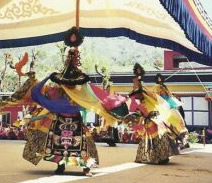 |
|
Stupa
with prayer flags Swayambunath Temple, Kathmandu |
Dancing
lamas © Palden Padma Samye Ling |
Losar—the Tibetan and Nepalese New Year festival (lo, ‘year’, sar, ‘new’)—has its roots in pre-Buddhist observances. At a time when the Bon religion was predominant in Tibet, rituals were performed each winter to appease the spirit protectors of the land, and after Buddhism was introduced to the region in the 6th century BCE, the new religion adapted the observance. Since the 13th century, Losar has traditionally fallen on the first day of the first lunar month.
The old must be dispensed with before the new year can begin, and on the 29th day of the twelfth lunar month there is a festival called Gutor—the ‘ghost-exorcising’ festival—during which everyone whitewashes and cleans their houses, and lamas perform masked dances to chase away evil spirits. A special container known as a phyemar containing zanba—roasted barley flour with butter—and barley seeds is prepared and placed on the family shrine along with offerings of wheat sprouts, beer, tea, biscuits, sweets, fruits and butter lamps.
At sunrise on Losar, the woman of the house burns incense at the well or river where she fetches the household water. To appease the local nagas—serpent spirits—she ties a white scarf around the tap or nearby tree and leaves them an offering of food. Everyone dresses in new clothing and sits down to a special breakfast. Prayers are offered at the family altar, and wishes of Tashe Delek, “good fortune”, are exchanged with the neighbours.
The well-being of the Dalai Lama is also a focus of the Losar observance. Consecrated “long-life” pills (tse-ril) made of roasted barley dough are presented to him by representatives of the monasteries and Tantric Colleges. Special dances are performed in his honour, and senior monks stage a debate on Buddhist philosophy.
As with New Year celebrations the world over, there is much revellry and drinking. But it is also a time to visit stupas and monasteries to offer prayers and to pay respect to the Buddha and the monks.